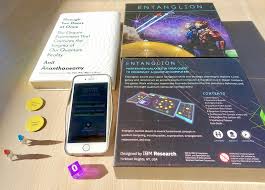Quantum chemistry is an important branch of chemistry that helps us understand and study the behavior of matter and energy at the atomic and subatomic level. Quantum theory was developed in the early 20th century by great cathedrals such as Max Planck, Albert Einstein and Niels Bohr. Which is continuously used in physics till today.

Some of the main reasons for quantum mechanics are as follows
1. Understanding of atomic structure: Quantum mechanics helps us understand the structure of atoms and the different behavior of electrons so that it can be easily identified.
2. Development of new technology: Quantum mechanics has promoted the development of new technology of transistors, lasers and computer technology.
3. Future technology: The quantum of quantum mechanical is the quantum matrix, which can help advance the progress of future technology.
4. New spectrums have been introduced about the nature of quantum mechanical reality and our understanding of the universe has been explained.
What is quantum theory? Let us know in detail –
Quantum theory, also known primarily as quantum mechanics, is the branch of physics that studies the behavior of matter and energy at the atomic and subatomic level. At these scales, classical physics does not apply, and it is especially true that the phenomena of particles govern the behavior of particles. Which is quantum theory.

1. Wave-ear duality: Waves are like particles and both are like particles.
2. Sunlight principle: Some properties, like position and momentum, are absolutely different and cannot be observed at the same time.
3. Superposition: If two things are together, they can exist in different places in several states.
4. Quantum convolution: Ears can be connected, i.e. ears can tell each other’s momentum, which means that the position of one ear affects the other.
Some of the principles of this theory are as follows –
1. Transistor: Used in the building blocks of modern electronics
2. Laser: Explains the behavior of light through mechanical lasers.
3. Quantum complex has the ability to solve complex complexes very fast. These complexes can be solved.
4. Hieroglyphics: There are various different ways of securing statues
Implications:
Reality at the smallest scale: Reality itself challenges our understanding. Scientists and scientists: Quantum phenomena are probable. Our understanding of reality is very much related to this.
What is the quantum mechanical model of the atom?
1. Wave-particle duality: Wave-particle duality: Both wave-particle-like and particle-like behaviour are depicted.
2. Orbitals: The space occupied by atoms called orbitals is a region within a particular region of the atom called the orbital.
3. Energy levels: Different types of energy are occupied by atoms or shells of atoms called the energy levels.
4. Quantum numbers: The four quantum numbers (n, l, m, s) describe the energy, size and direction of the orbitals. These are the quantum numbers.
The quantum mechanical model of atom is a basic theory in chemistry and atom, which makes it easy for us to understand and know the quantum mechanical model of atom and atom.
1. List and learn atomic structures: Quantum particle models can also help us to understand and know the behavior of electrons in atoms.
2. Predicting chemical properties or probing the future: It helps in predicting the chemical properties and reactivity of chemicals to investigate the future.
Which scientist developed the quantum mechanical model of atom?
The quantum mechanical model of atom was developed by many scientists, the main scientists include:
1. Erwin Schrödinger
2. Louis de Broglie
3. Werner Heisenberg
4. Max Born
- Rishikesh Zipline ?
- Dal Lake kha hai ?
- Pakistan War ?
- Yog kya hai ?
- Pitthu uthane wale log kha se aate hai ?